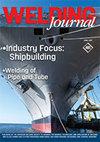利用先进制造技术修复高γ'热段燃气轮机部件
IF 1.4
3区 材料科学
Q2 METALLURGY & METALLURGICAL ENGINEERING
引用次数: 0
摘要
本文介绍了使用激光喷吹粉末沉积修复高γ'IN-100超级合金燃气轮机部件的能力。研究了各种工艺条件对在代用高γʹ合金上形成无裂纹 IN-100 沉积物的能力的影响,以确定沉积物和热影响区 (HAZ) 中的裂纹机制。利用多尺度表征和数值模拟评估了各种裂纹形成机制,如凝固裂纹和液化裂纹。沉积区的裂纹主要是凝固裂纹,而在热影响区观察到的裂纹则是液化裂纹。结果表明,控制热引起的残余应力是消除开裂的关键,并确定了最佳预热温度。然后将结果与已发表的文献进行对比,提出了一种有效修复热截面零件的方法。本文章由计算机程序翻译,如有差异,请以英文原文为准。
Repairing High γ’ Hot Section Gas Turbine Components Using Advanced Manufacturing
This article describes the ability to use laser-blown powder deposition to repair high γ’ IN-100 superalloy gas turbine components. The influence of various process conditions on the ability to make crack-free IN-100 deposits over surrogate high γʹ alloys was investigated to identify cracking mechanisms in the deposit and heat-affected zones (HAZs). The various crack formation mechanisms, such as solidification cracking and liquation cracking, were evaluated using multiscale characterization and numerical simulation. The cracking in the deposit region was predominantly solidification cracking, while those observed in the HAZ were liquation cracking. The results showed that controlling thermally induced residual stresses is the key to eliminating cracking, and the optimum preheat temperature was determined. The results were then contrasted with those in published literature and an approach to effectively repair hot section parts was presented.
求助全文
通过发布文献求助,成功后即可免费获取论文全文。
去求助
来源期刊

Welding Journal
工程技术-冶金工程
CiteScore
3.00
自引率
0.00%
发文量
23
审稿时长
3 months
期刊介绍:
The Welding Journal has been published continually since 1922 — an unmatched link to all issues and advancements concerning metal fabrication and construction.
Each month the Welding Journal delivers news of the welding and metal fabricating industry. Stay informed on the latest products, trends, technology and events via in-depth articles, full-color photos and illustrations, and timely, cost-saving advice. Also featured are articles and supplements on related activities, such as testing and inspection, maintenance and repair, design, training, personal safety, and brazing and soldering.
 求助内容:
求助内容: 应助结果提醒方式:
应助结果提醒方式:


